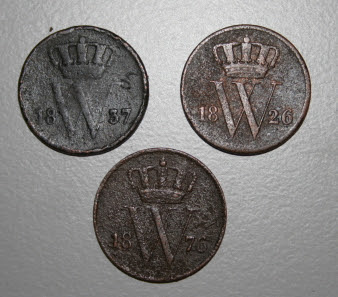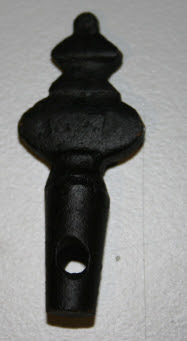Zelf zoek ik met een Explorer SE van Minelab

De Explorer SE werkt net als zijn voorganger volgens het FBS systeem (Full Band Spectrum) waarmee 28 frequenties tegelijk de grond in worden gestuurd, Daardoor onstaat een perfect systeem dat met alle grondcondities rekening houdt en bovendien niet alleen superdiep gaat maar ook nog eens heel gevoelig is! (deze gevoeligheid is bijvoorbeeld nodig om kleine en dunne voorwerpjes te vinden van zilver en goud.
Met de Minelab Explorer wordt in Engeland (samen met Tesoro/Laser) veruit het meeste 'hammerd silver' gevonden. Elke zoeker die een keer mee gegaan is naar Engeland zal dat bevestigen.
Geen enkele detector heeft het dieptevermogen, gecombineerd met de uitstekende discriminatie kwaliteiten en diverse andere innovaties van de Explorer. Door deze discriminatie kwaliteiten is het mogelijk om deze detector zo op te voeren, dat er nog goed gezocht kan worden waar andere detectors enkel nog storing oplopen.
Diverse Instellingen te vinden op het Web
Onderstaande programma's heb ik geprobeert en scoren goed op klein materiaal en tevens een goed diepte bereik.
Recommended Settings
Important - The Explorer has a number of settings however once setup the machine is nearly turn on and go most days. That said it's important not to get in a rut using a single setup for all site conditions. I tweak my standard setup to my advantage as the site conditions change. What works well for me on one side of a park may not work well on the other side, and neither may work well hunting an iron infested cellar hole in the woods or the beach. The Explorer has many good features, use them.
Sensitivity = Manual mode as high as it will go and be reasonable stable, I rarely will hunt at less than 25 and I'll put up with a bit of instability in exchange for the depth a higher Sens gives you. I almost always run 26-28 with the stock coil, 30 if the conditions are very good. I NEVER hunt in semi-auto because the machine has a bad habit of overcompensating for soil mineralization or nearby interference and lowering the sensitivity too far. You can often run the sens quite a few points hotter and still have very stable operation in manual mode. If you're in a super heavy iron condition, try lowering the sens to 20 or even 18 especially if the ground is sopping wet.
Threshold = personal choice, I like it just barely audible.
Volume = 10 max
Gain = 7. I have found this to be the best all around setting in my area. Deep targets still sound deep (different) from shallow targets yet they are not so faint that you have to strain to hear them. Be on the lookout for those fainter signals that repeat though, I found many a silver dime on edge with this machine and they don't give the more robust signal you get from a coin lying flat. Some guys hunt with the gain at 10, I get too many false signals that high. Often I can't even run the gain at 8 and 10 also does one other thing, it makes it difficult to tell the target depth by tone since all signals are amped up to the same volume level. One quite successful hunter uses a gain of 6 but I nearly missed some on edge coins at 7. The factory setting of 5 is too low.
Beach Tip: The Explorer is a bit hot for wet sand salt water beach hunting and can false on bits of seaweed. Its also sensitive to keeping the coil flat (versus tipping slightly at the end of your sweeps). If you find that its falsing to the point of being annoying try backing off the gain to 5-6 first instead of lowering the sensitivity. These false signals will not go away but they will become very faint to the point that you can just ignore them. A real target will sound MUCH louder and depth really is not an issue in beach sand. I was hunting a beach with a friend, he had his sens turned down to 18 to deal with this, I instead lowered my gain. I got a solid hit on a deep nickel (could have been a gold ring) that didn't make a peep on his machine.
Variability = 10 Max, this gives you the widest variation which I like, like having 100 possible tones verses 80, or 50 at lower settings. You can actually hear the difference between a mercury dime verses a barber/seated dime with practice, even the difference between a worn silver and one in good shape.
Limits = Max which is the recommended Minelab setting. I like the high pitch scream of silver!!!
Sounds = Ferrous. This is an excellent advantage the Explorer has over other detectors. Silver still sounds high but iron sounds low. We have tons of iron around here so this makes it quite easy to hear silver mixed in with the iron. The down side is that rusty bottle caps will sound high like silver in pitch but they tend to pop at the end which gives them away. I have some ideas about conductive tones, specifically whether they give you more depth versus ferrous tones that I will be experimenting with in 2006 but for now Ferrous is my normal setting.
Noise = if you have the XS just hit the Noise Cancel button after you startup the machine, if you have the S adjust manually for most stable operation.
Response = Normal, a few have experimented with the other options but most find this to be the best overall. I would not experiment until you have this machine down pat. Note some successful beach hunters like setting 2 for small gold.
Recovery = Fast Off, Deep On, this is very important. This combination gives deep coins a nice wide, robust signal which sticks out like a sore thumb compared with trash signals. But if you turn Fast on it will chop the signal off short and the coins will sound more like the short chopped off trash signals making learning the detector much more difficult. In my opinion it should only be turned on in heavy trash conditions and my advice is avoid those areas until you are confident with the machine in medium to light trash conditions and you have learned what the coins sound like. Don't ignore this feature, it can be useful.
Discrimination - I run all sorts of discrimination patterns, IM -16, -12, -8, Smart Find wide open except for rusty bottle caps rejected, Smart Find with the entire bottom 1/3 of the screen rejected, etc. Now 85% of the time I'm in IM -16 (all metal) or the equivalent with rusty crowncaps rejected but the point is don't get stuck in a rut hunting all site conditions in IM -16. And if I only have 90 minutes to hunt I may reject the most common trash targets and try to cover some more ground in the limited amount of time available. Sometimes I use a custom gold coin pattern that has little gold coin (and nickel) windows open in another otherwise rejected bottom 1/3 of the screen. To you IM -16 die hards, have a little fun with the machine once in a while.

































































